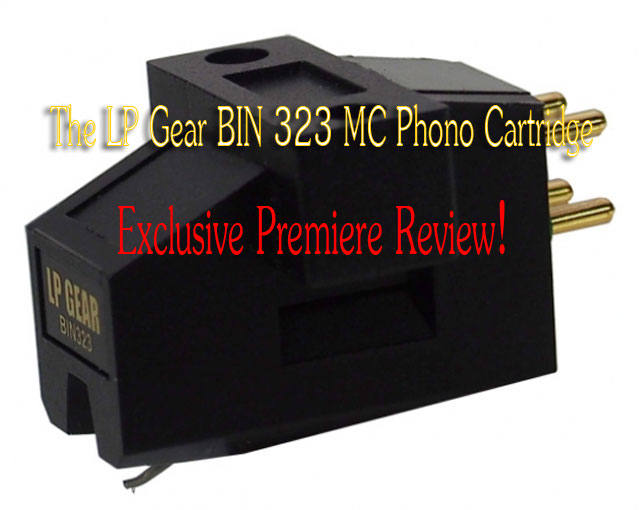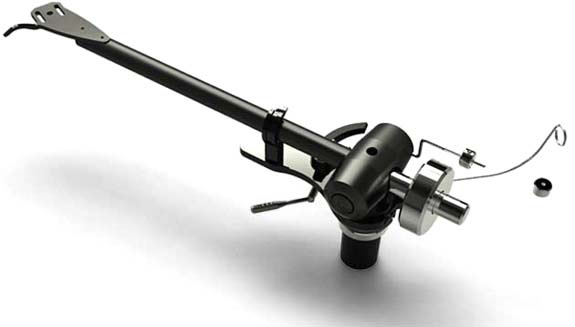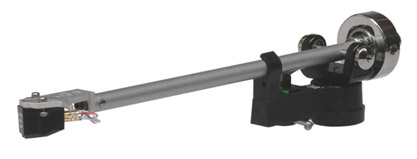LP Gear BIN 323 MC Phono Cartridge

I’ve always had a deep respect for Rome Castellanes, the head honcho at LP Gear, the Nevada-based internet provider, of, you guessed it, LP gear. I’ve reviewed a batch of his LP Gear-labeled phono cartridges, along with most of the superb Graham Slee phono stages over the years. The musical results have been nothing short of exemplary. Castellanes has never excluded the impecunious from affording his products, in fact, just the opposite: he has searched for and developed truly excellent analogue products that even the discretionary-income-compromised music lover can afford.
The LP Gear BIN 323 High-Output Moving Coil phono cartridge is a further example of Castellanes’ canny ability to offer exceptional performance at what one can only describe as a budget price. The BIN 323 offers a 1.7 mV output at 47K Ohms resistance, so matching it with any MM phono input stage should present no difficulties, even though the 323’s output is one-half to one-third of most moving magnet cartridges. It utilizes a line-contact stylus mounted to an aluminum cantilever. Its inspiration was the old Supex cartridge line that first made moving-coil cartridges popular and affordable in the US in the 1970’s. The BIN 323 cartridge sells for $329. Yes, that’s right: $329.
Packaging is non-pretentious and basic: a set of cartridge screws, a removable stylus guard, and a one-gram headshell weight for those tonearms that might have problems balancing the cartridge.

I mounted the BIN 323 in the excellent Origin Live Onyx tonearm, fitted to a very early Origin Live Aurora MK2 turntable, which had been retro-fitted with OL’s Upgrade flat belt and Platter Glide super bearing oil. VTF was set at 2.0 grams and the arm was set at slightly negative (arm pivot point a bit lower than the headshell.) I casually played the cartridge for roughly 20 hours, then rechecked set-up. Nothing had changed. Overall the 323 proved very easy to live with and stable, its line-contact stylus fairly laissez faire about SRA/VTA set-up. There was a definite and profound ‘blooming’ of the cartridge’s performance at about 35 hours.
Origin Live’s turntables and tonearms provide exceptional sonics, coupled with absolutely top-drawer musical communication, and the BIN 323 proved a very willing and adept dance partner. I was seduced by the 323’s charms immediately. No sonic aberrations stuck out, and listening for flaws in its playback proved fruitless. Instead I was drawn into listening to the music without any distractions from the cartridge’s performance. Which is exactly what we want our audio systems to do. Right?
I routinely use about 20 test LPs drawn from a wide variety of musical genres to test various performance aspects of review components, starting with hi-fi’s toughest and ultimate test: Classical music. Timbral reproduction of strings, woodwinds, brass, piano, and percussion was highly accurate, allowing immediate identification of what instrument was playing. Instrumental placement of the instruments was also non-distracting, thus, the basic what and where of psychoacoustic perception were readily met, eliminating the main hindrances to musical enjoyment. The brain/ear simply doesn’t like disorientation.
While the sound staging performance might not have been as hallucinogenically vivid as some ultimate gear can produce, there was zero ambiguity as to where the instruments were positioned. Height information (e.g., the woodwinds’ higher and deeper placement in the sound-field compared to the strings’, and the percussion’s still higher and deeper placement) was clear and extremely welcome, as this is a difficult aspect of fidelity to reproduce in even cost-no-object audio systems. Moreover, rather than producing ‘islands’ of instruments, there was the sense of a continuous sound-field with individual instruments emerging from the venue’s acoustic ambience. No ‘Sounds emerging from a Black Hole’ nonsense.
So there were no audio/sonic problems, but sound per se doesn’t make music. It’s how sound is organized into meaningful musically communicative patterns that determines for me any component’s ultimate worth. Rhythm, drive, and timing were exceptionally good, as was musical punctuation and phrasing, mated to a strong depiction of flow. Thus the 323 wonderfully reproduced the musical meaning of the performance. It did this equally well with Classical music, acoustic Folk Music, Rock, and Jazz, thereby allowing free investigation of any genre of music. Music was exceptionally easy to understand, making listening a snap for musical illiterates like me (i.e., those who don’t play a musical instrument.) And most importantly, artistic distortion was very low. You might not be able to learn to exactly mimic virtuoso violinists like David Oistrakh by close-listening, but you will understand and appreciate their artistry.
One might argue that what I’m attributing to the BIN 323 is really the contribution of the excellent Origin Live front-end. This is of course true, but any cartridge will only do what the turntable and arm will let it do. The danger, I see, is that the BIN 323’s low price will tempt mounting it onto inadequate turntables, thereby blunting its magic. The opposing danger – mounting the BIN 323 into a far more highly resolving arm and thereby exposing its flaws – raises no concerns whatsoever.

I next installed the BIN 323 into a MKII Origin Live Silver arm. The sonic result was like Popeye eating his spinach. Dynamics, clarity, transparency, resolution, and bandwidth positively exploded. Sound staging now was hallucinogenic, the cartridge now competing successfully with cartridges fives times its price. Most importantly the 323’s musical communication also increased proportionately. You probably could learn to mimic Oistrakh by close-listening, as the increase in clarity vastly improved communication of the performer’s artistic and technical skills.
While it would not be too unfair to describe the 323’s performance in the Onyx arm as slightly sweet and forgiving, it was anything but in the Silver arm. The 323 wasn’t terribly neurotic about getting VTA/SRA absolutely spot on, but with the Silver arm you could change the cartridge’s sonic performance to taste as changes in arm height were immediately audible. As always with line-contact styli, bass and treble performance changes with arm-height changes, but you’d have to be pretty ham-fisted to totally screw-up the BIN 323. Still, careful attention to precise set-up paid great dividends in freedom from record noise, transient speed and control, and rendering the silence between notes.
Analogue playback offers the potential of infinite resolution. The inherent difficulty of achieving that ultimate potential in the LP format: – try removing a speck from the eye of a flea from 10 miles away with a bamboo pole. At night. In a hurricane. After drinking 50 cups of coffee. – means that, while achieving that perfection is extremely difficult, every genuine improvement in playback quality will be audible, significant, and musically meaningful.
The LP Gear BIN 323 is a most exceptional cartridge. Easily affordable, it offers music-making capabilities so good that I can make no criticism. Its ultimate resolution is so high that ascertaining its limits proved inconclusive: it just kept sounding better and better as playback components improved. The 323 is a break-through phono cartridge, easily the most complete sound-and-music affordable cartridge I’ve ever heard. It challenges cartridges at multiples of its price. Heady heights here, to be sure, but I find the BIN 323 impossible not to love. The cartridge is simply a must-listen and a must-buy. An instant classic.

![]()
paul szabady
Specifications
Price: $329.00 Regularly $399.00
○Tonearm mount: 1/2 inch
○Type: Moving coil (MC), high output
○Output voltage at 1kHz, 3.54 cm/sec: 1.7 mV
○Frequency response: 15 – 40,000 Hz
○Load impedance: 47 kΩ
○Channel separation at 1 kHz: 25 dB
○Output balance at 1 kHz: <1.0 dB
○Tracking force range: 2.0 – 2.3 g (2.0 g recommended)
○Coil inductance at 1kHz: 630 μH
○Static compliance: 15 x 10-6 cm/dyne
○Dynamic compliance: 10 x 10-6 cm/dyne
○Stylus: Nude Square Shank Line Contact
○Stylus shape: 5 x 20 µm
○Cantilever: Special aluminum alloy
○Vertical tracking angle: 23°
○Dimensions: 17(H) × 17(W) × 24.7(D) mm
○Weight: 4.0 g (5.6 g with brass mounting hardware and shim)
○Accessories included: Stylus protector (x 1), Brass screws (x 2), Brass nuts (x 2), Alignment Protractor, LP Gear 1.2 g Shim
LP Gear
3024 Via Venezia
Henderson, NV 89052 US
Fax: (725) 888-4711
https://www.lpgear.com/SFNT.html
Components used in this review
Origin Live Aurora MKII and Aurora Gold turntables, Origin Live Onyx, Silver II and Conqueror MKII tonearms.
Graham Slee Gram Amp SE and Reflex M, Pure Sound P10, phono stages of Hegeman HAPI One, Meitner PA6i, and EICO ST84 preamps.
Harbeth P3 ESR, Infinity RS7, and Sound Lab Dynastat loudspeakers.
One thought on "LP Gear BIN 323 MC Phono Cartridge"
Leave a Reply
Stereo Times Masthead
Publisher/Founder
Clement Perry
Editor
Dave Thomas
Senior Editors
Frank Alles, Mike Girardi, Russell Lichter, Terry London, Moreno Mitchell, Paul Szabady, Bill Wells, Mike Wright, and Stephen Yan,
Current Contributors
David Abramson, Tim Barrall, Dave Allison, Ron Cook, Lewis Dardick, John Hoffman, Dan Secula, Don Shaulis, Greg Simmons, Eric Teh, Greg Voth, Richard Willie, Ed Van Winkle, Rob Dockery, Richard Doran, and Daveed Turek
Site Management Clement Perry
Ad Designer: Martin Perry





Hi. You show this Phono Cartridge currently selling for $329.00. I checked with LP Gear and their current price is $399.00. So who sells this for $329.00?
Thank you!